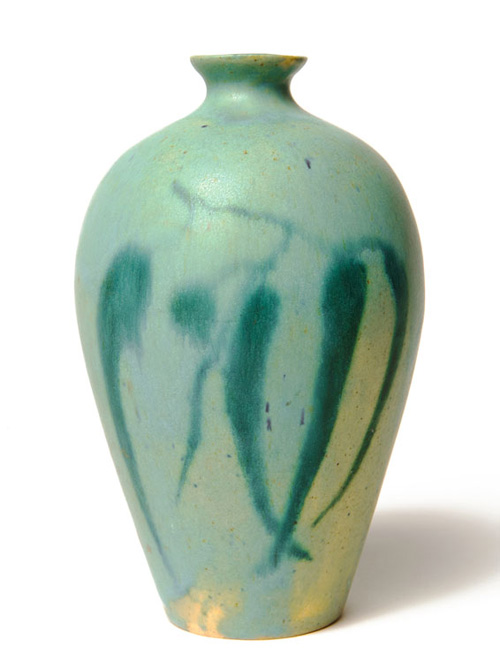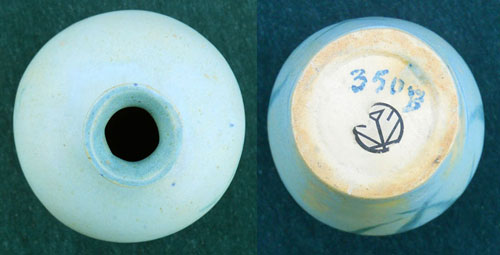|
WHITE PINES EUCALYPTUS VASE, ca. 1914
Jane Whitehead began ceramics lessons at the Byrdcliffe Pottery during the summer of 1913, and by 1915 the Whiteheads were already outfitting their own pottery. Despite the wealth of material evidence and surviving correspondence between members of the family, the reasons for their establishing a pottery separate from the Byrdcliffe enterprise are not clear. However, coming long after Byrdcliffe had become more of a Whitehead family compound than an Arts and Crafts colony, the act would probably not have been seen by the Whiteheads as competition with “the Pottery Ladies,” who ran the Byrdcliffe Pottery until 1923, with the help from time to time of Mabel Davison. According to a note in Jane Byrd Whitehead’s calendar, Zulma Steele took it over that year, operating it until at least 1928. The relationship between the White Pines and Byrdcliffe Potteries was never explicitly stated. The Whiteheads labeled their pottery “White Pines,” but Ralph gave his working address as the Byrdcliffe Pottery, according to the records of the American Ceramics Society, which he joined in 1917. Nevertheless, their products are easily distinguishable. White Pines pottery was slip-cast for the most part, although some pieces were wheel-thrown, and a few were hand built. Byrdcliffe pots were always hand built. The contemporary press said of them: “Misses Penman and Hardenburgh showed a number of their hand built pieces, which are ever interesting and show much appreciation of fine color, textures and form”; and, “The Misses Penman and Hardenberg [sic], whom many of us have watched as they built up one interesting shape after another at their pottery at Byrdcliffe in the Catskill mountains, exhibited a water jug and several bowls with colorful underglaze decorations.” Byrdcliffe ceramics were marked with a pair of stylized wings, impressed, and sometimes with “Byrdcliffe” and/or “Penman” and “Hardenburgh” also impressed. White Pines pottery displays a variety of marks. One is an arrow and a single wing wither incised or applied with glaze. Sometimes the initials RRW, standing for Ralph Radcliffe-Whitehead, are included with the wing and arrow device. Incised capital letters designate the clay body used, and painted numbers further identify the pots, which in some instances can be coordinated with Whitehead’s pottery record books and sales book. Also a black and white paper label, comprising a circle with a stylized pine tree, remains on some of the pots. In addition, some pots have paper price labels or price labels or prices marked on the bottom. Through evidence compiled from correspondence, Whitehead’s record books, and plans, photographs, and drawings remaining at White Pines, there unfolds a fascinating account of the couple’s working methods, the division of labor between them, their goals, both aesthetic and commercial, and the not inconsiderable role that pottery making played in their emotional lives. Jane’s first lessons were undoubtedly from Penman and Hardenburgh, but upon her return to California in the fall of 1913, she turned for instruction to the internationally respected ceramist and teacher Frederick Hurten Rhead, who had established a pottery studio and school in Santa Barbara that year. Jane’s calendar entries record that she met with the Rheads the day after her arrival in California, and five days later she noted: “Carried to Pottery all biscuits.” She must have transported her biscuit-fired pots from Woodstock to Santa Barbara, seeking specific help with glazes. Documents reveal business and social relationships between the Whiteheads and the Rheads as well, the Rheads having come to Christmas dinner in 1913, and in early January Jane noted, “R[alph] takes share in Pottery.” The following summer Jane worked again with Penman and Hardenburgh, and during August she attended ceramics classes at the University of Chicago. A calendar entry, “Whitford,” on her first day of classes identifies her instructor as William G. Whitford, formerly of the Buffalo Pottery. After Jane’s return to Woodstock in late August, Ralph, whose interest in his wife’s work heretofore could have been considered merely supportive, began to take an interest in making pottery himself. Jane wrote: “He has been helping me daily in the pottery work, & I am very grateful. I really think it must interest him a bit.” Her speculation proved correct, for in January 1915 Ralph began to keep detailed records of his own work, and he wrote to his son, “Mother and I have burnt the pottery today. I think we can find out some of the processes of pottery in the next two months. But you cannot learn much about a craft like pottery unless you work at it daily for a couple of years. Anything else is merely amateurish!” With his fear of amateurishness, Ralph pursued mastery of the craft for the next decade. The last of his pottery record books was dated 1926. |


